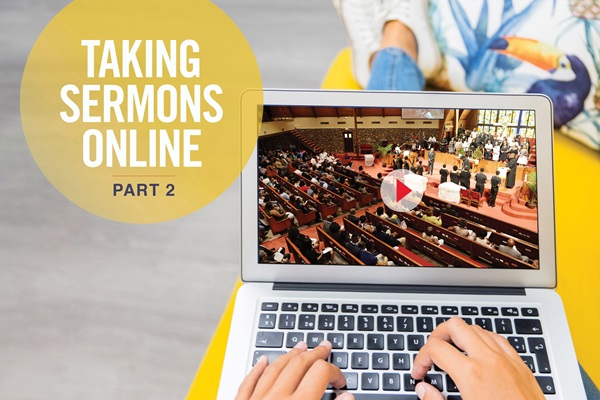In part 1, we covered why digitizing existing content (especially weekly sermons and lessons) makes perfect sense. Ultimately, making your sermons available online allows you the opportunity to reach more people and touch more lives. (Sounds like evangelism!)
It's a lot easier and less time-consuming to make content available digitally than you may first imagine. Here are eight ideas to repurpose and keep your sermons alive after the worship service.
Turn sermons into blog posts
With a robust sermon outline, turning a message into a blog post via copy/paste is pretty easy! Some people in your congregation naturally get more out of reading than listening. Furthermore, the written form can serve as message reinforcement a week, a month or even a year later.
Blogs are one of the most easily shareable forms of digital media, and they're perfect for extending your message to a far-reaching audience. Plus, most blog platforms allow readers to subscribe to the blog for regular updates; this way, you can build regular readership for your sermons.
Turn them into shareable audio
Sermon audio is perfect for a long walk, a drive or a workout. Posting MP3s of sermons on your church website should be a given, as it’s the first place members and visitors familiar with your church will check. But think beyond that to reach another (perhaps underserved) audience through a more mobile-friendly channel.
SoundCloud is to audio what Instagram is to images. People can follow your sermons and offer feedback through comments. Plus, SoundCloud makes it easy for people to share your sermons across Facebook and Twitter.
Turn sermons into videos
You don't need professional production skills to film services and create a YouTube channel for your church. Good quality video is available using a single videocamera, webcam or a smartphone mounted on a tripod.
YouTube videos get 4 billion views a day, and it's the second largest search engine in the world. It's insane not to put this powerhouse to use for your church. YouTube is the place to be if you're looking to maximize your audience and increase the odds of appearing in search results.
Vimeo has great things going for it, too. The pro version (plans begin at $20/month) features a player you can tailor in cool ways, including embedding your logo into the player and customizing your video URLs.
Turn them into livestream events
Services that are streamed live are often a lifesaver for your members who can't get the kids out the door in time for services. It's also a great opportunity to minister to shut-ins, members stuck sick at home and people who lack transportation.
Whatever the reason for absence, people at home can participate in the service as it's happening. People tend to prefer tuning into a live service than watching a pre-recorded one.
You don't have to make a big investment to get started. Plenty of churches have tested the waters by using free tools like Google Hangouts or Facebook Live.
Turn sermons into e-books
E-books are ideal for making multi-part sermons… available to your congregation or to visitors. The simplest and most cost-efficient way to publish one is to write it in Google Docs and convert it to a PDF. Pull an entire sermon series into a single PDF, and you have something to offer people visiting your website as a download in exchange for their email address (aka lead generation).
Turn them into social media posts
One of the easiest things you can do with your sermon is to excerpt best quotes and use them as social media posts or memes. Don't forget to watermark or link the quote with your church's website link.
Turn sermons into shareable slideshows
Visuals used to illustrate or highlight your sermon points can be made available as downloads for your sermon audio, video or as stand-alone content.
Slideshare is a powerful slide hosting service that draws 60 million visitors a month. It allows you to upload your files as PowerPoint, PDF, Keynote and OpenDocument presentations.
A great thing about SlideShare is that it's SEO-optimized, making it possible for people to discover your sermon visuals as they search for similar content. It is, in a sense, the search engine of document-sharing.
If your church already uses the Google Apps suite, then using Google Slides makes perfect sense.
Through its editor, you can write or quickly make changes within Slides, creating the content online instead of having to write offline and then upload the finished file. The simplicity and shareability of Slides make it hard to beat.
(Bonus idea from UMCom) Turn them into a webinar
Take your strongest sermon or topical series to the next level by adapting it as a webinar, featuring a member, pastor or other leader discussing key points.
A webinar shouldn't feature the pastor preaching the sermon again. (You already have sermon video [#3 above] for that!) At United Methodist Communications, we find the more casual the presentation, the more engaging, authentic and relatable it is as a webinar.
These eight ideas are meant to help lessen the writing load for pastors and class leaders. By sharing your sermons beyond the Sunday service, you'll keep online content fresh while expanding your audience and evangelism by way of proven content marketing! We'd love to hear from you about how you extend the life of your sermons.
Pushpay builds world-class digital giving solutions and custom smartphone apps designed for faith-based organizations.

